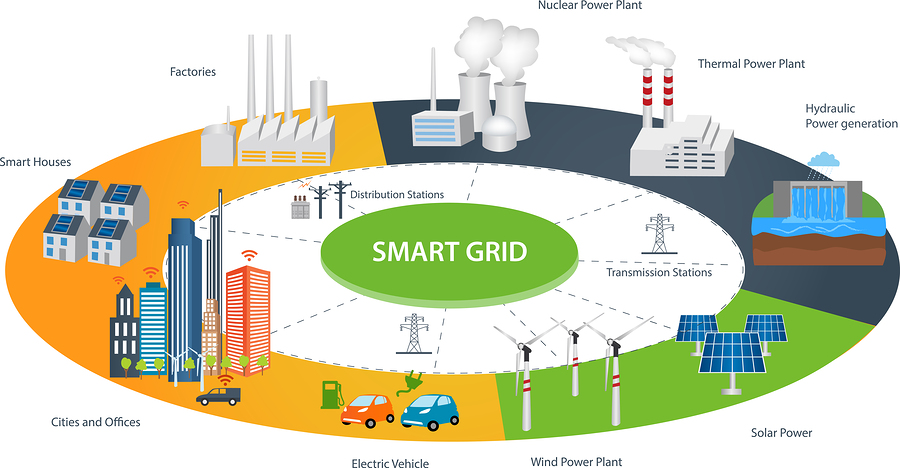
Robohub.org
Why artificial intelligence could be key to future-proofing the grid
 A recent Conversation piece pointed out that the British electricity mix in 2016 was the cleanest in 60 years, with record capacity from renewable energy, mainly from wind and solar power. But one problem with this great expansion in renewables is they are intermittent, meaning they depend on weather conditions such as the wind blowing or sun shining. Unlike conventional power, this means they can’t necessarily meet surges in demand. Hence many press headlines in recent years about the “lights going out”.
A recent Conversation piece pointed out that the British electricity mix in 2016 was the cleanest in 60 years, with record capacity from renewable energy, mainly from wind and solar power. But one problem with this great expansion in renewables is they are intermittent, meaning they depend on weather conditions such as the wind blowing or sun shining. Unlike conventional power, this means they can’t necessarily meet surges in demand. Hence many press headlines in recent years about the “lights going out”.
National Grid, the UK grid operator, has several ways of ensuring supply can always meet demand. For shorter gaps in generation, it asks electricity suppliers to run their conventional power stations at below maximum potential output and ramp up as needed.
For longer gaps, it ensures power stations, particularly gas-based ones, are kept on standby. Some stations may only be asked to generate power for between several dozen and a few hundred hours a year. Besides contributing to carbon emissions, operating power plants for such short interventions is expensive.
The question is what to do about this problem. We could build less renewable power and make conventional power “greener” instead by removing the CO₂ and burying it underground. Opinion divides on when these carbon capture technologies can be made commercially viable on a large scale. In the UK, unfortunately two government kickstarter projects have floundered due to concerns about costs and departmental disagreements.
An alternative is to install very big (“grid scale”) batteries capable of storing renewable power to be released when required. This has generated a lot of interest lately. But given the costs of current battery technology, grid-scale storage requires expensive upfront investments.
Solutions on demand
While researchers study these problems, the UK is developing an alternative known as demand-side response. One aspect involves rewarding certain electricity consumers for reducing their usage at short notice. This can range from large industrial customers to smaller consumers using power for heating rooms, cooling, lighting or even refrigeration.

Solar thermal energy system in a modern house.
The other aspect of demand response involves asking customers who own equipment that can store power to help balance surges in demand. For example, the owners of a house equipped with solar panels and corresponding battery storage might reduce repayment costs on the equipment by making the battery units available to the grid. Other equipment in this category includes electric vehicles and hospital/university uninterruptible power supply (UPS) units.
Both types of demand response are happening already. Some industrial power customers and certain other companies such as hotel operators have contracts for reducing power, while National Grid has been attracting much bidder interest for power storage schemes and has some underway in parts of the country. This storage is an alternative to deploying large-scale batteries, and promises to be much more economical if we can make it work on a large enough scale.
Once a pool of customers is set up, some devices might not always be available for storage or reducing demand when needed. This needs to be factored into the calculations both to minimise grid disruption and incentivise customers to participate at these times.The problem is that these schemes get more complicated once the pool of customers gets beyond a certain size. Knowing which customers to sign up and what tariffs to offer requires understanding to what extent devices will be available and at what cost, for example.
There can also be undesired effects, such as large simultaneous rebounds in consumption. For example many refrigerators will draw extra power to get their internal temperature below the required level when a demand response period ends.
Finally there’s a potential major security issue: a central system that collects data about energy usage from many devices may be prone to malicious attacks and information tampering. This could undermine both grid balancing and keeping track of what customers are owed.
How AI can help
Emerging artificial intelligence technologies look like providing answers to these challenges. To select the best participants, for example, grid operators will be able to use sophisticated machine-learning techniques to model the behaviour of individual devices and battery storage units by reviewing data from smart meters and sensors.

Smart Grid concept Industrial and smart grid devices in a connected network. Renewable Energy and Smart Grid Technology Smart city design with future technology for living.
Once signed up for grid storage, it should be possible to estimate the useful lifetime of a battery pack or unit by applying prognostic algorithms to its charging/discharging data. Owners will then receive appropriate compensation, plus the added incentive of knowing how long their battery will last.
When it comes to managing devices in the pool, people used to think we could use individual smart meters or control devices to feed a central server in the cloud. But meters are expensive and the short response times require the cloud server to analyse data in milliseconds, which looks unfeasible once many thousands of units are in a pool.
An alternative is to have metering devices which detect demand levels on the grid themselves and reduce power accordingly. These take pressure off the central server and it only requires metering at site level, rather than for every electrical device. But it still leaves you with a complex control problem in coordinating all these individual decisions. We at Heriot-Watt are working on a solution to this using AI-based algorithms.
Another line of AI research draws on insights from algorithmic game theory to develop reward/penalty mechanisms which ensure enough customers in the pool are willing to participate, and actually respond when necessary. Researchers are also optimistic that blockchain protocols, using the same technology as Bitcoin, could underpin a decentralised ledger system that would get round the security risk of having a single storage point for user data.
Numerous AI research groups, both in the UK and elsewhere, have been addressing these challenges, while a number of start-ups have started developing such systems in practice – relatively simple versions of machine learning are now beginning to be used, for instance. The UK has a good chance to be at the forefront of international efforts to make smarter demand response a reality over the next few years.
This article was originally published on The Conversation.
You might also enjoy the following articles:
- Wearable AI that can detect the tone of a conversation
- Artificial intelligence and ethics: Who does the thinking?
- Soft exosuit economies: Understanding the costs of lightening the load
- MIT Media Lab to participate in $27 million initiative on AI ethics and governance
See all the latest robotics news on Robohub, or sign up for our weekly newsletter.
tags: AI, Algorithm AI-Cognition, Algorithm Controls, Artificial Intelligence, c-Education-DIY, cx-Business-Finance, opinion




